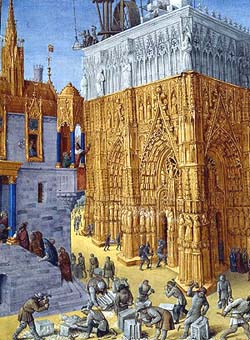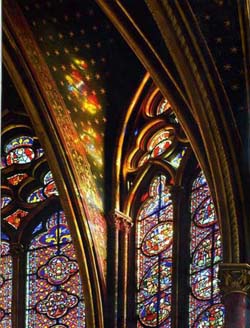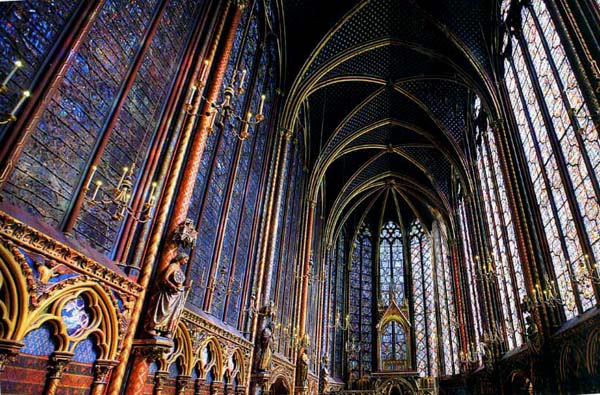 |
Symbolism
Medieval Cathedral Symbol of Heaven
Plinio Corrêa de Oliveira
The excerpt that is the subject of my commentary today was taken from a work by Marcel Aubert, a very good historian, about the cathedral as a symbol of Paradise (Le Gothique à son apogee).
I believe it opportune to revisit the notion of symbol so that you may benefit more fully from this text.
The author affirms that the cathedrals were not conceived just as covered buildings to protect people from the rain and wind so that they could worship God. Beyond this indispensable material aim, the cathedral should also be a symbol of Paradise. It should be a building to make men think about Heaven and give them a fore-taste of it, a construction in some way similar to Paradise to represent the latter to men. Thus, the cathedrals were true works of art rich in symbolism. Everything in them had a symbolic meaning.
The author examines this symbolism in one aspect of the cathedral: as a place where God dwells. In it man can be in His presence and in the presence of the Blessed. Thus, he begins: “The Cathedral is an image of the City of God, the Celestial Jerusalem, an image of Paradise, as the liturgy for the consecration of churches affirms.”

The Catholic King builds the earthly Jerusalem, the civil order according to Christ |
Here he expresses two ideas: The first idea is the reflection of the City of God, of the Celestial Jerusalem.
As you know, Jerusalem was the Holy City of the Old Testament, which represented in a material way what the Catholic Church would be, the Kingdom of God on earth.
There were three symbols of the Catholic Church in the Old Testament: the Chosen People was a pre-figure of the faithful of the Catholic Church. Jerusalem was the capital of this people and also a symbol of the institution of the Church. Finally, the Temple of Jerusalem, where sacrifice was offered to God, was a symbol of the Catholic Church as the only place where God is worshiped. These were concentric symbols representing the Catholic Church.
Sometimes Jerusalem is also used to express the ensemble of the temporal order organized according to the principles of Our Lord Jesus Christ. Analogically, the ensemble of the heavenly order is also called the Celestial Jerusalem, which is synonymous to Paradise.
The second idea refers to the liturgy of the consecration of churches. All churches – and therefore also cathedrals – are consecrated before they are used for the divine cult, and a special liturgy exists for this purpose.
The text continues: “Its lateral walls correspond to the Old and New Testaments. Its pillars and columns are the Prophets and Apostles that support the cupola, which represents Christ as the center.”
This is a beautiful idea. When passing by a church, it is something we can keep in mind.
The author goes on: “The stained-glass windows that separate us from the storms and let the light pour over us are the Doctors.” How poetic is this!

The light that gives beauty to everything is symbol of God |
“The threshold is the entrance to Paradise adorned with stone statues, gilded and painted bas-relief sculptures and rich bronze doors.”
Thus, the doors of Heaven are signified by the doors of the cathedrals on earth. Those doors of bronze or carved in oak or other noble woods with many images on both sides emphasize the symbolism of the entrance into Heaven. This should remind us that the doors of Heaven invite us to enter into the glory of God; the organs of Heaven, which are the songs of the Angels, are ready to resound to acclaim us when we enter the Celestial Cathedral.
“The House of God must be illuminated by the rays of the sun, resplendent with charity like Paradise itself, because God is Light, the light that gives beauty to every existing thing. For this reason, the light inside the cathedral should be amplified, with the windows made as large as possible, from the top of the great arches to the cupolas.”
Since God is light, it is appropriate for the cathedral to have light, not the raw light of day, but light filtered by stained glass windows as much as possible. Thus, we can understand the battle of gothic architecture to enlarge the windows as much as possible without harming the stability of the edifice. This battle continued until architecture reached the perfection of Saint-Chapelle in Paris, a veritable jewel, in which all the walls are stained glass windows. The only stone in the structure exists in the form of columns to sustain the roof. All the rest is light; it is a box of light; a box of crystal where all the colors of light play, forming marvelous designs, reminding us of the eternal light of Paradise.
It would be good for you to always have a copy of this text at hand, and when you enter a church, to read it again to learn this symbolism until it becomes a habit for you to make these symbolic relationships. Looking at the columns, remember that they are symbols of the Apostles or Prophets. Entering though its doors, remember that one day you are supposed to pass through the doors of Heaven and meet the Apostles and Prophets. Above all, there you will be inundated with divine light, just as here you are bathed in the light that enters through the stained glass windows in the church.
The edifice of the church should increase our hope for the triumphs of Heaven.
When we feel oppressed, persecuted and hated on this earth, we should turn our eyes to Heaven and long for Paradise, where these miseries will end, and where there is endless happiness with no fear that anything can ever disturb it.
To understand how transitory happiness on earth is, imagine a youth who says, “I will live until 90 years in complete happiness.” This is the most he can have. After that, a catastrophe called death comes and his earthly happiness ceases. But, there is no end to the happiness of Heaven. It lasts forever. If someone were to say to one of the Blessed that he would have to return to earth after 3,000 years in Heaven, this would tarnish his happiness. This is because happiness on earth is insignificant next to the happiness of Heaven. Just the idea of returning to earth projects a shadow of sadness on heavenly bliss.
It is to this end, Heaven, that we journey, especially when life seems too long, too hard. After spending 3,000 years in Heaven, 90 years on earth will seem like a short sojourn; nothing but a brief period that passes quickly. In turn, 3,000 years in Heaven is nothing, because it will last for eternity. It will be a bottomless ocean of happiness contemplating God face to face and with all the gratifications of Heaven for our brother body.
This is good to remember when we enter a church so that we cultivate the virtue of hope, which is the longing for eternal goods with the firm confidence that Our Lady wants us to receive them.
Let us end this evening with the thought of the hope of Heaven.

A box of crystal where all the colors of light play ... reminding us of the eternal light of Paradise
|

Translated from the script of a tape
based in notes by A.S. Guimarães
Posted December 14, 2011

Related Topics of Interest
 The Cathedral, Symbol of Paradise The Cathedral, Symbol of Paradise
 Stained Glass: Light, Colors & Symbols Stained Glass: Light, Colors & Symbols
 The Middle Ages, a Forest Filled with Symbols The Middle Ages, a Forest Filled with Symbols
 Gothic Riches Gothic Riches
 Reading Medieval Architecture Reading Medieval Architecture

Related Works of Interest
|
|
Symbolism | Religious | Home | Books | CDs | Search | Contact Us | Donate

© 2002- Tradition in Action, Inc. All Rights Reserved
|
 |
|